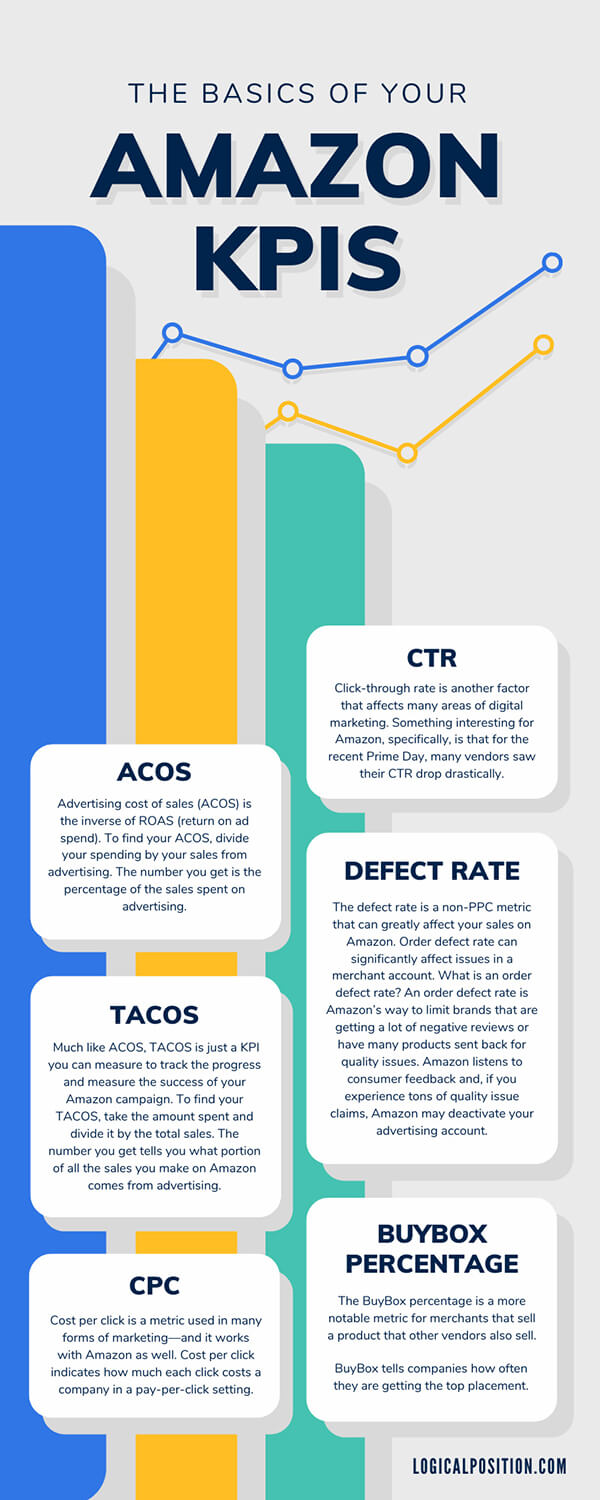Amazon is a platform many brands prioritize selling on. Companies want to capture the broad audience of consumers actively searching to buy products on this platform. When you sell on Amazon, it’s essential to remember the key role advertising plays on the platform.
Unlike pay-per-click ads on Google, sales from Amazon PPC ads can directly impact organic rankings. On Amazon, sales velocity is a ranking factor for organic search results, and advertising sales impact total sales velocity. Understanding this drives many brands to invest heavily in advertising.
When you choose to advertise on Amazon, paying attention to the performance of your ad dollars is vital to adjusting the campaign to reach its full potential. Check out the basics of your Amazon KPIs so you can lead your business to success.
ACOS
Advertising Cost of Sales Formula
Ad Spend / Ad Sales = ACOS
Advertising cost of sales (ACOS) is the inverse of ROAS (return on ad spend). To find your ACOS, divide your spending by your sales from advertising. The number you get is the percentage of the sales spent on advertising.
While there is no one-size-fits-all solution for an ideal ACOS, understanding your goals as a company can inform what ACOS to strive for. For example, if a company is looking to increase its sales velocity, a higher ACOS may be acceptable. For companies looking to maximize profits from advertising, they may want to opt for an ACOS goal that leaves plenty of wiggle room in their profit margin.
The ACOS is a primary metric to monitor. If a company chooses to hire a professional Amazon PPC agency to help with its campaigns, this is the first metric to share with the account manager.
Pro Tip: ACOS does not factor in Amazon’s fees or manufacturing fees. Take these in mind when looking at overall KPIs for your Amazon efforts.
TACOS
Total Advertising Cost of Sales Formula
Ad Spend / Total Amazon Sales = TACOS
You may see “TACOS” and think, “What does a delicious treat have to do with marketing?” But TACOS on Amazon is an important business metric. Much like ACOS, TACOS is just a KPI you can measure to track the progress and measure the success of your Amazon campaigns.
To find your TACOS, take the amount spent and divide it by the total sales. The number you get tells you the ratio of advertising spend to total Amazon sales, which is useful for evaluating your budget and impact for advertising campaigns.
If the number is very low, it could mean the business is underspending on advertising. While there are no one-size-fits-all TACOS goals, under 15 percent is generally considered “healthy”, though this will differ based on industry and margins.
For businesses who currently have a low TACOS percentage, there is often room for investment in their business through advertising, which can lead to growth in overall sales.
Pro Tip: When calculating TACOS, make sure your date ranges are the same on both Seller Central and the Advertising Console. If one is set to 7 Days, and one to 30 Days, your calculations will be very wrong!
CPC
Cost Per Click Formula
Spend / Clicks = CPC
Cost per click is a metric used in many forms of marketing—and it’s an essential part of Amazon Advertising as well. Cost per click indicates how much each click costs a company in a pay-per-click setting. For example, Google also offers a PPC option.
CPC is on the rise across all platforms currently offering PPC advertising. The theorized reason is that at the beginning of the COVID-19 pandemic in March of 2020, many companies—including the largest ones—drew back their advertising budgets because of the uncertainty surrounding business restrictions, job loss, and overall impacts of the pandemic.
In response to the drop in demand for PPC ads, prices lowered drastically. Now that things are becoming more settled in the economy and the distribution of the COVID-19 vaccine is beginning to progress, companies are ramping up their advertising budgets again, driving up the prices for PPC ads.
Pro Tip: If CPC fluctuations have your costs rising, this can cut into your returns, so factor that in and watch the trends closely.
CTR
Click-Through Rate Formula
Clicks / Impressions = CTR
Click-through rate is another factor that affects many areas of digital marketing. Something interesting for Amazon, specifically, is that for the recent Prime Day, many vendors and sellers who weren’t running sales saw their CTR drop drastically.
This is likely due to the browsing that happens when there are tons of deals to sift through. It’s likely that shoppers clicked through things quickly to browse but had little purchase intent. Especially for Prime Day, many vendors and sellers saw their CTR get cut in half if they were not running a promotion.
Whether on Prime Day or any other day of the year, poor CTR can reflect the impact of any changes made. Here are several things that can affect CTR on Amazon.
- Price changes (dropping or raising the cost of a product)
- Changes to the product image
- Changing the title of the product
- Gaining or losing the Prime badge
- Gaining or losing the ‘Amazon’s Choice’ badge
Pro Tip: It can be valuable to observe what your competitors are doing when it comes to CTR. Your product listing has to stand out in some way against the competition, whether that be pricing (including running a sale), your primary image, or if you’re lucky enough, winning the “amazon’s choice” badge.
Order Defect Rate
Order Defect Rate Formula
Orders with Defects / Total 60 Day Orders = Defect Rate
The defect rate is a non-PPC metric that can greatly affect your sales on Amazon. Order defect rate can significantly affect issues in a merchant account. What is an order defect rate? An order defect rate is Amazon’s way to limit brands that are getting a lot of negative reviews or have many products sent back for quality issues.
There are three main types of “Defects” that can put your Amazon account in poor standing. They are
- Negative Feedback
- A-To-Z Guarantee Claims
- Credit Card Chargebacks
Amazon listens to consumer feedback and, if you experience tons of quality issue claims, Amazon may temporarily restrict your advertising account. If an Amazon Seller reaches an Order Defect Rate above 1%, Amazon has the potential of temporarily deactivating your account. This stops your brand from advertising and shuts down all of your ad campaigns, which can have massive implications on sales.
Buy Box Percentage
The Buy Box percentage is a more notable metric for merchants that sell a product that other vendors or sellers also sell.
For example, if Company A sells a product but also has distributors at Company B and Company C, then on Amazon, Company A must compete with Company B and C to sell the exact same product. Amazon will show customers the lowest-priced item and or fastest shipped item (among other factors).
In this case, if Company B decides to sell the product at a lower price than Company A and C, customers will likely purchase from Company B, even if Company A is the manufacturer.
Buy Box Percentage tells companies how many sessions they have won that buy box given the total sessions that product has received over a given period.

There are many metrics to pay keen attention to when you advertise on Amazon. The competition is often fierce, so paying attention to the small changes in your metrics can help you get ahead. The basics of your Amazon KPIs will help guide your campaigns. If you’re ready to get a jump on the competition, contact Logical Position today about our Amazon advertising services.
As an Amazon Partner agency, we have a direct line of communication with Amazon and pass our exclusive insights on to our clients. Our priority is your success, and we take a very granular approach to ensure you reach or exceed your goals. Contact us today for a free consultation.




